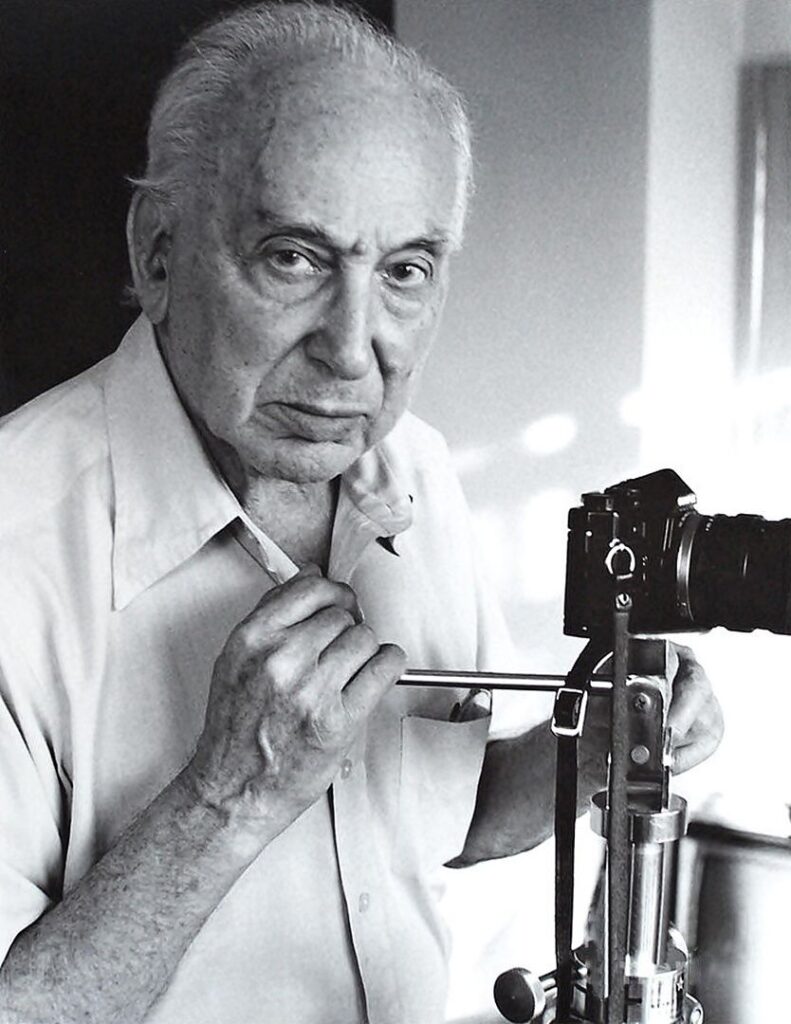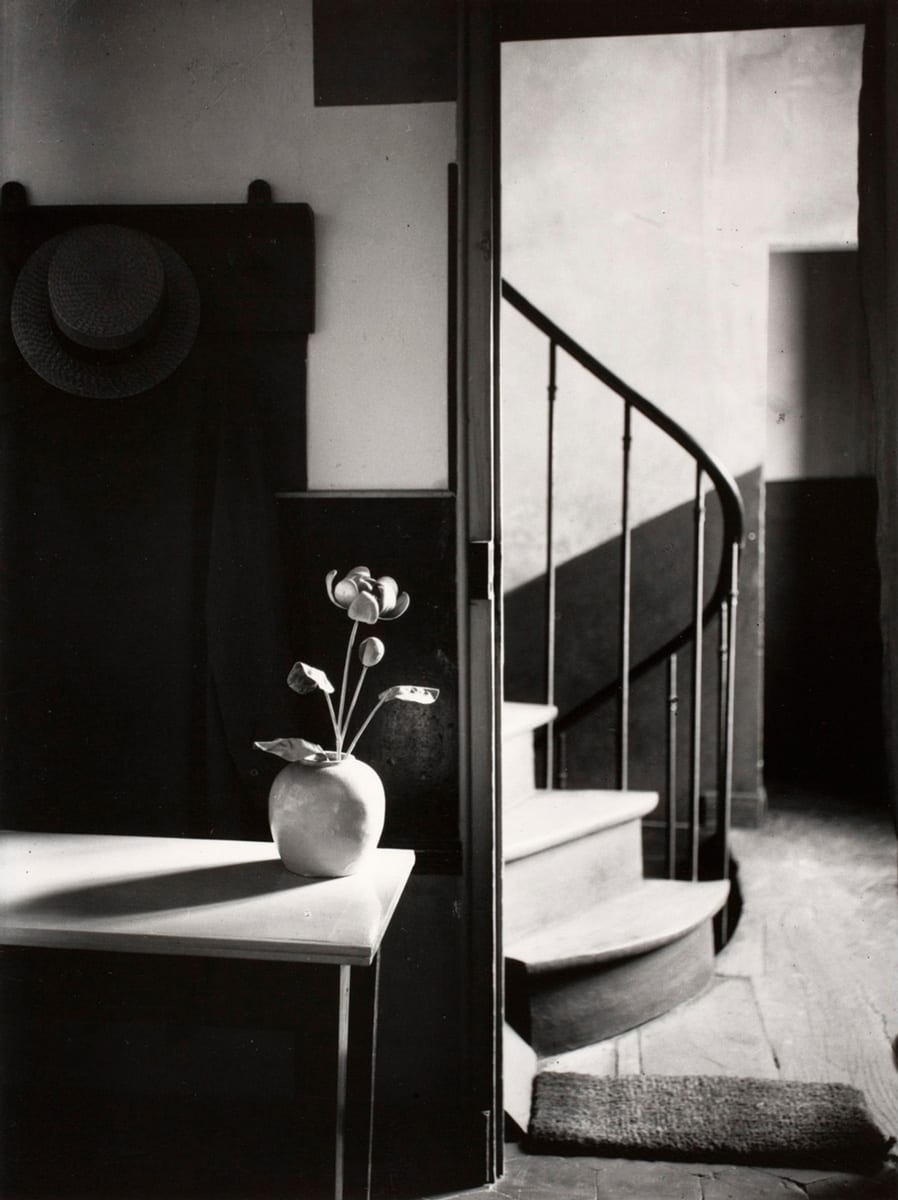In the pulsating heart of Paris, against the backdrop of the vibrant cultural scene of the 1920s, the Hungarian photographer André Kertész, surprised everyone by creating an image that goes beyond time and space. Through his eye, he brought the inner view of Dutch painter Piet Mondrian’s studio known as “Chez Mondrian, Paris” to life. This masterpiece is an embodiment of his superb composition and poetic portrayal of ordinary life. Together let us enter the realm of André Kertész, through whom we will discover an interesting photo and simultaneously understand the stories that it contains.
Who was André Kertész?

André Kertész, an emigrant from his homeland of Hungary, is appreciated internationally as one of the greatest photographers. In 1894, Kertész was born. He took up photography in the early 20th century, and until his death, he remained a dominant force and left a legacy of his distinct vision and style. His paintings often dealt with common situations, poetically developing them, and thus turning the usual into the extraordinary.
In his early years, Kertész was experimenting with different photographic techniques and improving his skills so that he was able to create his style, which is characterized by its closeness and emotionality. His photographs were telling, they unveiled the hidden poetry that was wrapped into the texture of the daily world. Through the capturing of fleeting moments of urban life and the quiet beauty of nature, Kertész imbued his photographs with timeless qualities, allowing viewers to reflect on the mysteries of existence.
FUN FACT: André Kertész was known for his quirky sense of humor, which often found its way into his photography. Despite capturing poignant moments and profound emotions, Kertész had a playful side that manifested in his work.
His Career
Kertész’s relocation to Paris in the 1920s brought the necessary change in his career. Immersion in the lively cultural field of the city became a source of his art inspiration from the works of other artists and intellectuals who went to the cafés and the salons of Montparnasse. This is a period in which he built connections with famous people, such as Piet Mondrian (whose studio was the background of one of Kertész’s most famous photos).
He was a real trailblazer in photography and went ahead to try new techniques while remaining faithful to his artistic vision. Through his images, he pictured urban life modernly, showing the essence, beauty, and complexity of the human experience. Whether it was the busy streets of Paris or the towering skyscrapers of New York City, Kertész’s lens was enough to create a portrait of the chaotic world in transition, amidst which one could find beauty and transcendence.
What is Happening in Chez Mondrian, Paris?

| Artist | André Kertész |
| Date Created | 1926 |
| Medium | Gelatin silver print |
| Genre | Documentary photography |
| Period | Modernism |
| Dimensions | 24.4 cm × 19.2 cm (9.6 in × 7.6 in) |
| Series / Versions | N/A |
| Where is it housed? | Currently housed in the J. Paul Getty Museum, Los Angeles |
“Chez Mondrian, Paris” remains as constant evidence of André Kertész’s peerless command of composition in the field of photography and his unique talent for capturing the very essence of a moment and compressing it into a single frame. Dated to 1926, this photograph is a touching memorial to the abode of Dutch painter Piet Mondrian in Paris. A small room becomes a kaleidoscope of the physical space as well as the invisible force of creation which was the driving force behind Mondrian’s art.
The photograph becomes a kind of audiovisual poem that conveys the same ideas as Mondrian’s principles of geometric abstraction and harmony. All the elements in the frame are arranged carefully, from the sharp lines of furniture to the light and darkness that circulate through the room. By way of Kertész’s lens, Mondrian’s studio becomes a haven of creative actuation, where the artist’s revolutionary thinking found form amid the outside world’s disorder.
What’s So Special about Chez Mondrian, Paris?
“Chez Mondrian, Paris” vividly portrays Mondrian’s studio. It features minimalism and carefully ordered geometric shapes. Viewers are drawn into an ambiance of peace. Through Kertész’s use of light and shadow, the composition gains depth, enriching harmony and balance.
Interesting Facts About Chez Mondrian, Paris
“Chez Mondrian, Paris” provides a visual documentation of Mondrian’s studio. It also reveals the artistic camaraderie shared between Kertész and Mondrian. Their mutual respect shines through in this timeless photograph.
Despite its simple subject matter, “Chez Mondrian, Paris” captivates. It inspires artists and enthusiasts alike. Its enduring appeal transcends time and space, inviting contemplation of simplicity amid chaos.
Artwork Spotlight: Heavy Burden, Esztergom, Hungary

Kertész’s pursuit of capturing the everyday beauty did not stop there. His major work ‘Heavy Burden, Esztergom, Hungary‘ epitomized a moment of everyday struggle, demonstrating the courage of the human spirit against tough times.
Frequently Asked Questions
What is André Kertész famous for?
His photography in the 1960s and 1970s served as an inspiration to many other modern photographers. In all spheres of postwar photography, Kertész’s work is historically significant because he fused a formalist concern for abstract shapes with a photojournalistic interest in movement and gesture.
What camera did André Kertész use?
Kertész used a Leica camera to capture what appears to be a straightforward street scene in this mysterious image. Three years before Henri Cartier-Bresson, in the 1920s, Kertész was seen with a Leica from 1928. Because it was lightweight and simple to use, photojournalists quickly began to like the camera.
Conclusion
“Chez Mondrian, Paris” transcends mere photography. It’s a visual poem, uplifting the human spirit. Through Kertész’s lens, beauty and harmony captivate. This transitory image captures the essence of artistic imagination and inspiration.












